C/1998 P1 Williams
more info
Comet C/1998 P1 was discovered on 10 August 1998 by Peter Williams (Heathcote, Australia).
At the moment of discovery, C/1998 P1 was about 2 months before its perihelion passage and it was last observed in the mid-May 1999.
Comet had its closest approach to the Earth on 28 July 1998 (0.887 au), about 2 weeks before its discovery.
This is a comet with nongravitational effects strongly manifested in positional data fitting.
Solutions given here are based on data spanning over 0.758 yr in a range of heliocentric distances: 1.56 au – 1.15 au (perihelion) – 3.13 au.
This comet suffers large planetary perturbations during its passage through the planetary system; these perturbations lead to a significantly more tight future orbit with semimajor axis of about 830 au. See also Królikowska 2020.
Comet had its closest approach to the Earth on 28 July 1998 (0.887 au), about 2 weeks before its discovery.
This is a comet with nongravitational effects strongly manifested in positional data fitting.
Solutions given here are based on data spanning over 0.758 yr in a range of heliocentric distances: 1.56 au – 1.15 au (perihelion) – 3.13 au.
This comet suffers large planetary perturbations during its passage through the planetary system; these perturbations lead to a significantly more tight future orbit with semimajor axis of about 830 au. See also Królikowska 2020.
| solution description | ||
|---|---|---|
| number of observations | 461 | |
| data interval | 1998 08 11 – 1999 05 15 | |
| data type | perihelion within the observation arc (FULL) | |
| data arc selection | entire data set (STD) | |
| range of heliocentric distances | 1.56 au – 1.15 au (perihelion) – 3.13 au | |
| type of model of motion | NS - non-gravitational orbits for standard g(r) | |
| data weighting | YES | |
| number of residuals | 905 | |
| RMS [arcseconds] | 0.78 | |
| orbit quality class | 1b | |
| orbital elements (barycentric ecliptic J2000) | ||
|---|---|---|
| Epoch | 2313 02 25 | |
| perihelion date | 1998 10 17.67445750 | ± 0.00028310 |
| perihelion distance [au] | 1.15084835 | ± 0.00000705 |
| eccentricity | 0.99851798 | ± 0.00000630 |
| argument of perihelion [°] | 294.618458 | ± 0.000508 |
| ascending node [°] | 156.577210 | ± 0.000059 |
| inclination [°] | 145.724989 | ± 0.000079 |
| reciprocal semi-major axis [10-6 au-1] | 1,287.76 | ± 5.48 |
| file containing 5001 VCs swarm |
|---|
| 1998p1n1.bpl |

Upper panel: Time distribution of positional observations with corresponding heliocentric (red curve) and geocentric (green curve) distance at which they were taken. The horizontal dotted line shows the perihelion distance for a given comet whereas vertical dotted line — the moment of perihelion passage.
Lower panel (panels): O-C diagram for this(two) solution (solutions) given in this database, where residuals in right ascension are shown using magenta dots and in declination by blue open circles.
Lower panel (panels): O-C diagram for this(two) solution (solutions) given in this database, where residuals in right ascension are shown using magenta dots and in declination by blue open circles.
